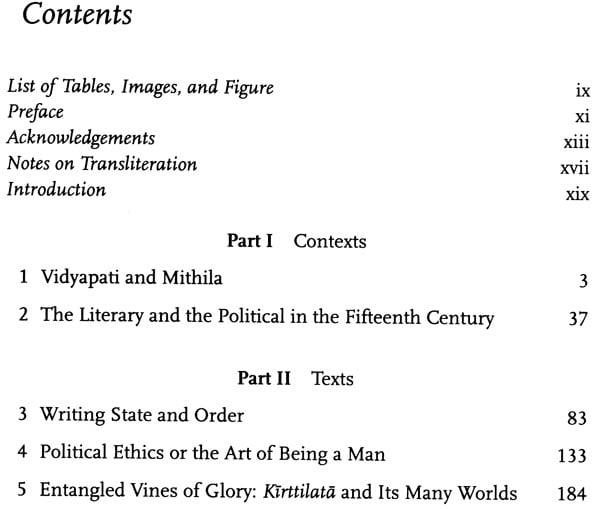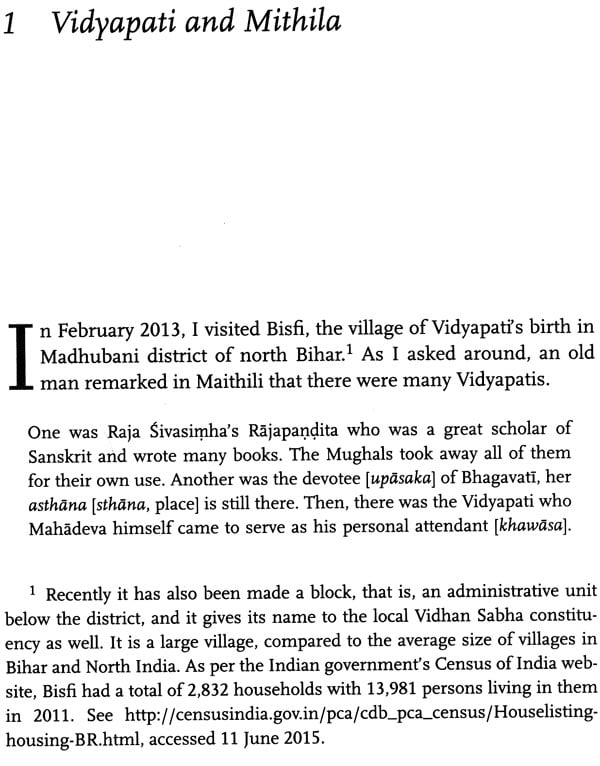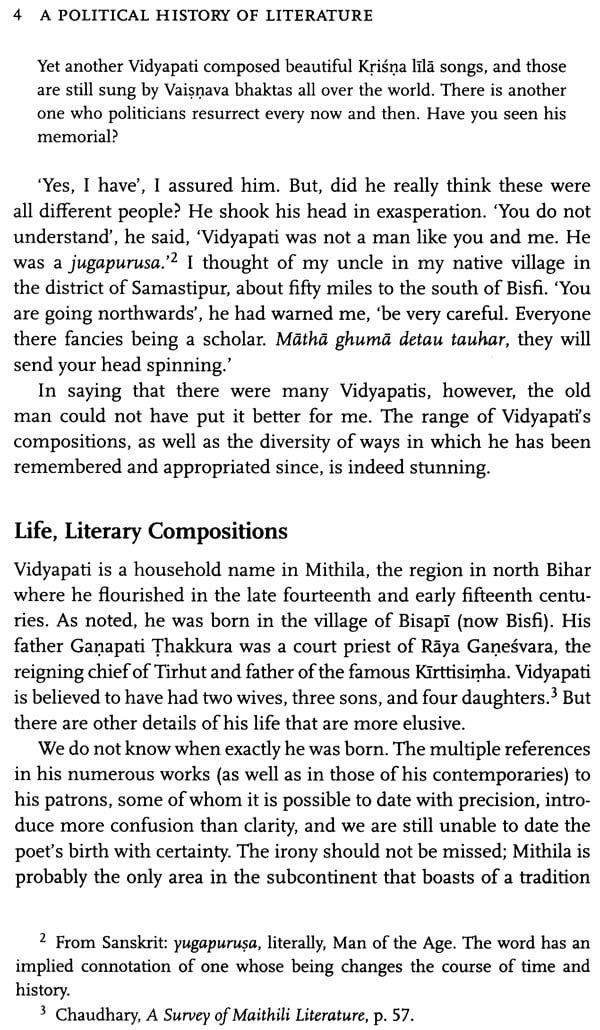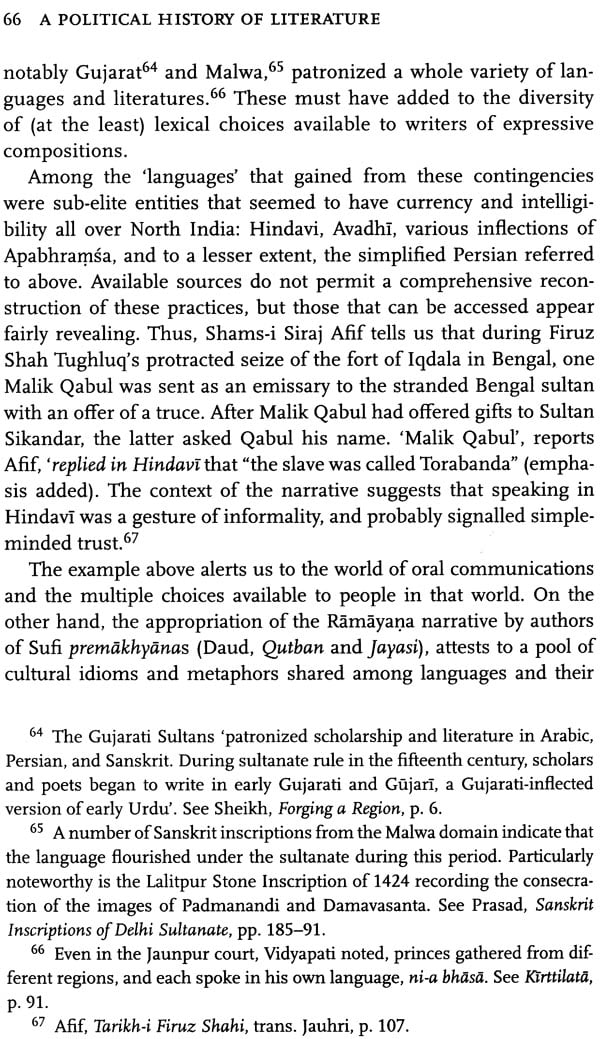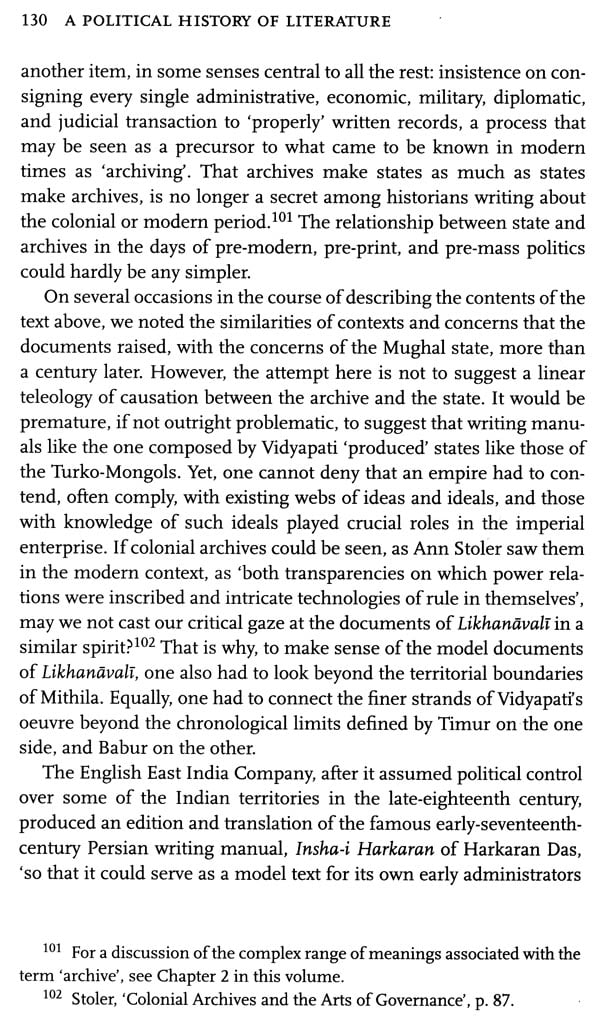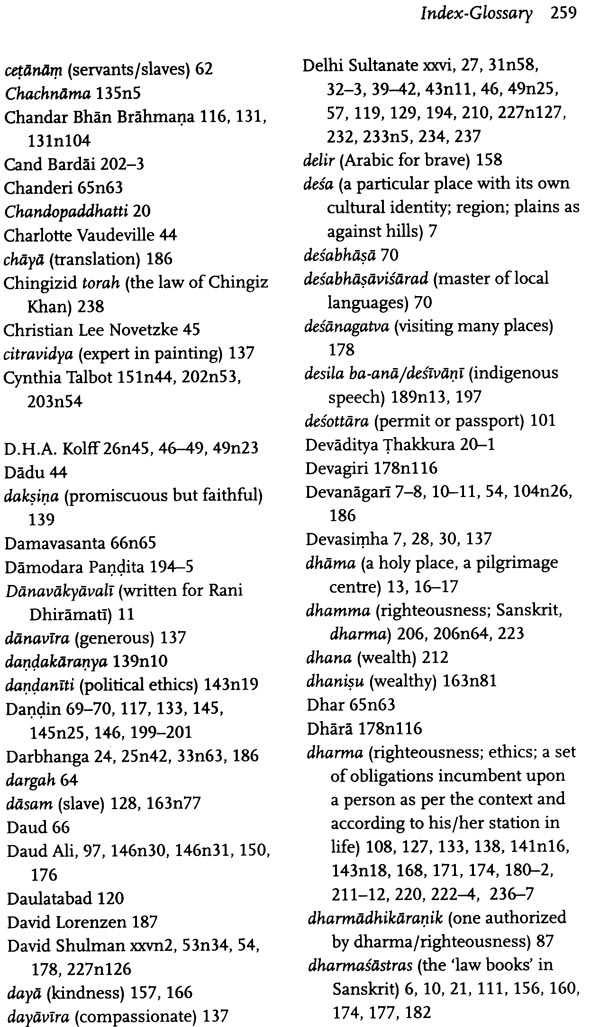
A Political History of Literature - Vidyapati and the Fifteenth Century
Book Specification
| Item Code: | NAQ388 |
| Author: | Pankaj Jha |
| Publisher: | Oxford University Press, New Delhi |
| Language: | English |
| Edition: | 2019 |
| ISBN: | 9780199489558 |
| Pages: | 299 |
| Cover: | HARDCOVER |
| Other Details | 8.50 X 5.50 inch |
| Weight | 500 gm |
Book Description
Multilinguality gained a new impetus in North India with the influx of West Asian Muslim communities around the thirteenth century. Over a period of time, it entered everyday life as well as creative and scholarly pursuits. The fifteenth century, in particular, saw unprecedented vitality for literary practice, and the poet-scholar Vidyapati from Mithila was one of the many luminaries of the time.
This volume encompasses an intimate linguistic, literary, and historical study of three of Vidyapati's major works: a Sanskrit treatise on writing (Likhanavali); a celebratory biography in Apabhramsa (Kirttilata); and a collection of mytho- historical tales in Sanskrit (Puru~aparik~a). Through this examination, the author reveals a world that is marked by a range of ideas, expertise, literary tropes, ethical regimes, and historical consciousness, drawn eclectically from sources that belong to 'diverse' politico-cultural traditions. Using Vidyapati's narratives, A Political History of Literature illustrates that many ideals extolled in fifteenth- century literary cultures were associated with an imperial state-a state that was a century away from coming into being-and testifies that ideas incubate and get actualized in realpolitik only in the long duration.
Pankaj [ha is presently teaching at Lady Shri Ram College, New Delhi, India. He is giving final touches to his English translation of a fifteenth- century Sanskrit treatise on writing, entitled Likhanavalr. He is also on the editorial board of the international journal Indian Economic and Social History Review. Earlier, [ha has taught at Ramjas College and St. Stephen's College, New Delhi.
Tha obtained his bachelor's and master's degrees in history from Ramjas College, and his M.Phil and PhD degrees from the University of Delhi. Part of his doctoral work was done at University of Texas at Austin, U.S.A, on a Fulbright-Nehru fellowship. The primary area of his research interest is the literary cultures of the middle ages. Languages he has worked with include Persian, Sanskrit, Maithili, and Apabhramsa. He has published research articles extensively in peer-reviewed journals, in Hindi as well as in English.
This book is a partially revised version of my PhD thesis sub- mitted to the University of Delhi. My doctoral work had started more than a decade ago with three counts of dissatisfaction with the existing state of historiography in the field normally referred to as 'medieval India'. The first of these was the fact that the fifteenth century in north India was, with only the rare exception, a barely addressed period. In fact, even these exceptions did not exist at the time when I started thinking about the area of my research. The second point of dissatisfaction issued from the fact that a major chunk of the historiography of this period in North India appeared to have become synonymous with Persian studies. The 'mainstream' histories of 'medieval' North India rarely bothered to consult the large corpus of extant materials in Sanskrit, thus catering lazily to the popular and hugely problematic equation of medieval Persian Muslim foreign. The third point had to do with the disappearance of the regions falling in the present province of Bihar from 'histories of medieval India'. This absence was especially hurtful as I spent the first seventeen years of my life in Jamshedpur, a part of the then undivided Bihar. Under the circumstances, a close study of some of Vidyapati's works came in very handy, since he was a Sanskrit scholar and poet of the fifteenth century, who spent most of his life in north Bihar. Since the inception of my work, there has been some exciting new work in the area, and I discuss some of it in the second chapter of the book. This book, I hope, will add further force to the gathering momentum.
At a time when we are exhorted 24 x 7 to understand politics as the game played by those who occupy the offices of the state and those who aspire to replace them, it is important to recover a slice of history when intellectual ferment, dissemination of ideas, ethical regimes, and cultivation of certain skills, such as those of documentation, seem to have had substantive political consequence in the long term. While this is probably true of all times, it is more starkly visible in a period during which readymade histories and master-narratives of imperial formations were not produced. North India in the 'long fifteenth century' is a case in point when we do have this unusual silence.
When I made the fateful journey from a humble Hindi-medium school to Ramjas College, Delhi, it was a huge task to cope with the heat, dust, English language, and cultural alienation in a metropolitan city. Unfortunately, neither of the two factors that helped me survive and grow in spite of the material hostilities has survived. It was the 'leisurely' pace of the annual system that allowed 'slow-wits' like me to adjust to the demands of the academic rigours of University of Delhi. Come 2010, and that leveller of the academic field was forced to give way to a ruthless system of six-monthly examinations and continuous assessment, with no space to make mistakes and learn on the go. One of my first companions in the college campus, hardier and more sincere than most of us, was Rakesh. His raw humility, desi humour, extraordinary generosity, and candid affections steadied many wayward souls like myself. He is no more. He would have taken personal pride in this book. I dedicate it to his memory.
This book has been conceived as a political history of literature in the fifteenth century. It is neither an exhaustive consideration of all literature produced in that age in North India, nor does it claim to be a treatment of a 'representative' sample of all such compositions. Rather, I have focussed on three sharply different texts of a prolific poet, Vidyapati, from an atypical region, Mithila. I have tried to use the three texts under consideration to open up the wider world of literature in the fifteenth century. Thus, I relate Vidyapati's compositions to the existing traditions of literary production of the time, with a view to unearth the deeper histories that lay behind them. Given the state of the relevant historiography, this was a huge methodological challenge.
The book is organized in five chapters, which are unevenly divided in two parts, preceded by a short introduction, and followed by a conclusion. The conclusion ties up the points made by the different chapters both at a general, methodological level, as well as in the specific context of the long fifteenth century, in a way that might connect its details with certain larger questions of contemporary as well as historical significance.
The first part of the book has two chapters: the first provides basic information about Vidyapati, his compositions, and his immediate geopolitical and intellectual milieu. The second chapter takes critical stock of the more dominant and recent strands of historiography of the 'long' fifteenth century. But it also uses this critical stock-taking as a step towards (a) broadly mapping the literary cultures of the fifteenth century, and (h) thinking about issues of historical method, historians' possible engagements with literature, knowledge formations, and power, as a set of related themes. The second part of the book has three chapters, each centred around, but not limited to, one of the texts of Vidyapati, namely, Likhanavali, Purusapariksa, and Kirttilata, out of more than a dozen of his compositions available in print whose authorship is not disputed. While I do refer to the poet's other compositions whenever the context requires me to, these are not taken up for detailed exploration.
Before I move to the next section, let me put in an explanation for why I treat Mithila as an 'atypical' region. The 'region' of Mithila was atypical in two distinct ways. First, at a moment when a robust system of long-distance trade had developed in most parts of the subcontinent, Mithila lay on none of the major trade routes of the time. Second, for related reasons, Mithila continued to survive as either an independent chieftaincy or as a semi-autonomous principality of the three major sultanates of the long fifteenth century in its neighborhood: Delhi, Jaunpur, and Bengal. It was only in the mid-sixteenth century that it emerged as an integral and separate territorial unit of a major imperial power, namely, the Mughal state. As such, it figures only marginally in the standard narratives of the Delhi Sultanate or the other sultanates up to the first half of the sixteenth century.
Why Vidyapati?,p> When I started researching the enormous corpus of literature left behind by Vidyapati, all I knew was that I wanted to focus on non-Persian textual productions of the fifteenth century. Medieval historiography has hitherto shown little patience with the fifteenth century, and precious little interest in non- Persian 'sources'. Vidyapati, however, was doubly attractive because he was multilingual and lived in Mithila, an area that modem historians, like most Persian chroniclers of the middle ages, often passed by quietly. And yet, Vidyapati's literary corpus was vast, disparate, and straddled a range of what appeared to be unconnected worlds. There was law, love, writing, political ethics, biography, rituals, tantricism, 'geography', romantic play, ritual donations (dana), and a vast corpus of songs for a variety of occasions. My problem was to focus on specific issues, and accordingly on certain texts, so I could study the author and his oeuvre more intimately.
After weighing in all my options, I decided to focus on the following three of Vidyapati's compositions. Kirttilata was a text I could not have avoided for the simple reason that it was the only major extant work of Vidyapati that was composed in Apabhramsa. Since one of my concerns was to examine the relationship between language, literature, and politics, this explicitly political text-a biopolitical narrative in 'vernacular' with a local prince as its protagonist-suggested itself 'naturally'. Purusapariksa was another work that appeared unique in the history of Indic literatures, being possibly the only known early modem text that so directly propounded what might be termed a theory of masculinity. That it was simultaneously a work on naya/dandaniti, or political ethics/ state policy, also suited my proposed engagement with issues of literature and state formation, or more generally, knowledge and power. No less compelling for me was the choice of Likhanavali, again for the simple reason that it was possibly the first text of its kind in Sanskrit. Being so centrally concerned with the state, this work too could add variety to my investigation of matters related to another 'literary' dimension of state power, namely, documentation. As I hope to demonstrate in the third chapter, however, Likhanavali turned out to be much more than what it claimed, a manual for those interested in cultivating the craft of documentation. A first-of- its-kind Sanskrit text that borrowed imaginatively from a range of literary traditions including Persian, it provides a glimpse into the eclectically constituted ways of making literature and imagining imperium in the fifteenth century.
